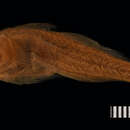en
names in breadcrumbs


Sufflogobius bibarbatus és una espècie de peix de la família dels gòbids i de l'ordre dels perciformes.[4]
Menja fitoplàncton.[5]
És depredat per Raja clavata, a Namíbia per Merluccius productus, i a Sud-àfrica per Merluccius capensis,[7] Merluccius paradoxus,[8][9] Helicolenus dactylopterus, Chelidonichthys capensis i Arctocephalus pusillus pusillus.[10][11][12][13]
És un peix marí, de clima subtropical i demersal que viu entre 0-340 m de fondària.[5][14]
Es troba a l'Atlàntic oriental: Namíbia i Sud-àfrica.[5] [15]
És inofensiu per als humans.[5]
Sufflogobius bibarbatus és una espècie de peix de la família dels gòbids i de l'ordre dels perciformes.
The pelagic goby (Sufflogobius bibarbatus), also known as the bearded goby , is a species of true goby from the family Gobiidae, native to the southeastern Atlantic Ocean. It is currently the only known member of its genus.[1]
It reaches a maximum length of 17 centimeters (6.7 in). It has 7 dorsal spines and 12-13 dorsal soft rays. It has a single anal spine and 12-13 anal soft rays. Its fins are dusky to black in color.[1]
This goby is demersal, inhabiting depths of 0–340 metres (0–1,115 ft) in subtropical waters ranging from 11–15 °C (52–59 °F) in the coastal waters of Namibia and South Africa.[1]
The bearded goby is usually found offshore but was also recorded in shore pools. Juveniles are epipelagic, while adults migrate to deeper waters, and large adults are only recorded from demersal trawls.[1]
The gobies can stay on the ocean floor for at least 10 to 12 hours at a time in an area of de-oxygenated "toxic sludge" rich in hydrogen sulfide H
2S where hardly anything lives except bacteria and nematodes. When settled on the bottom, they remain alert, showing rapid escape responses. They use the toxic mud as a refuge. Their population is growing despite the fact that they are now the main prey species in this unusual ecosystem.[2]
In 2010 was observed to feed on a species of jellyfish which was understood to be its main predator.[2][3] Jellies provide up to 1/3 of the fish's diet. It hides from mackerel amongst the jellies' stinger-covered tentacles when it rises from the seafloor for nighttime feeding.[4]
Fishes, penguins, Cape cormorants, crested terns and fur seals and jellies eat this fish.[1]
This goby hides from predators within jelly tentacles when it rises to feed and reoxygenate its blood.
Although targeted by purse seines, it may also be caught incidentally in trawls.
Miller, P.J. 1990
The pelagic goby (Sufflogobius bibarbatus), also known as the bearded goby , is a species of true goby from the family Gobiidae, native to the southeastern Atlantic Ocean. It is currently the only known member of its genus.
El gobio barbudo (Sufflogobius bibarbatus) es una especie de pez perciforme de la familia Gobiidae.
Los machos pueden llegar alcanzar los 17 cm de longitud total.[1][2]
Come fitoplancton.
Es depredado por Raja clavata, en Namibia por Merluccius productus y en Sudáfrica por Merluccius capensis ' '
Es un pez de mar Sudáfrica, de clima subtropical y demersal que vive entre 0-340 m de profundidad.
Se encuentra en el Atlántico oriental: Namibia
Es inofensivo para los humanos.
El gobio barbudo (Sufflogobius bibarbatus) es una especie de pez perciforme de la familia Gobiidae.
Sufflogobius bibarbatus Sufflogobius generoko animalia da. Arrainen barruko Actinopterygii klasean sailkatzen da, Gobiidae familian.
Sufflogobius bibarbatus Sufflogobius generoko animalia da. Arrainen barruko Actinopterygii klasean sailkatzen da, Gobiidae familian.
Sufflogobius bibarbatus is een baarsachtige uit de familie der Gobiidae.
Sufflogobius bibarbatus wordt maximaal 17 centimeter lang en heeft donkere vinnen.
Hij leeft in scholen en leeft vooral van fytoplankton en is zelf een prooi voor pinguïns, zeevogels, grotere vissen, bruinvissen en zeeberen.
Onderzoek van de Pennsylvania State University wees uit dat deze grondel ook overleeft in water met een laag zuurstofgehalte. Ze werden waargenomen in water dat in de jaren 60 en 70 van de 20ste eeuw, na overbevissing op sardines, werd overspoeld door kwallen. De grondel eet deze kwallen, hoewel de grondel zelf ook op het menu van die kwallen staat. Sufflogobius bibarbatus is hiermee één van de weinige organismen die kan overleven in het zuurstofarme water, dat hem beschermt tegen roofdieren en hem voedsel verschaft. Hoewel hij na het wegvallen van de sardine ook het enige prooidier is in de omgeving, weet hij er toch in aantal toe te nemen. Door op kwallen te leven, brengt de grondel ook die dieren weer in de voedselketen; andere dieren laten kwallen meestal links liggen. Hoe de vis tot meer dan 10 uur lang kan overleven in het zuurstofarme water is nog niet bekend. Het water is bovendien ook giftig, te wijten aan bacteriën die er waterstofsulfide uitscheiden. Het is evenmin bekend of de grondel de kwallen actief bejaagt of dode exemplaren van de bodem opruimt.
Sufflogobius bibarbatus komt voor in volle zee in de Atlantische Oceaan nabij Namibië en Zuid-Afrika, maar werd ook al aangetroffen bij de kust. Hij leeft er op de zeebodem op dieptes tot 340 meter en bij temperaturen tussen 11 en 15 °C. De jonge exemplaren leven meer aan het wateroppervlak, de oudere exemplaren op de bodem.
Sufflogobius bibarbatus is een baarsachtige uit de familie der Gobiidae.
Sufflogobius bibarbatus – gatunek ryby z rodziny babkowatych (Gobiidae).
Żyje w chłodnych wodach o temp 11–15 °C, na głębokości 0–340 m. Zazwyczaj żyje w ławicach na pełnym morzu choć bywa spotykana przy brzegu. Osobniki młodociane są epipelagiczne, dorosłe żyją w głębszych wodach.
Osiąga 17 cm długości. wzdłuż linii bocznej 48–54 łuski. Na łukach skrzelowych 12–14 wyrostków filtracyjnych, 2–3 na górnej i 10–11 na dolnej części. W płetwach grzbietowych 7 twardych i 12–13 miękkich promieni, w płetwie odbytowej 1 twardy i 12–13 miękkich promieni. W płetwach piersiowych 21–23 promienie.
Płetwy mają kolor śniady do czarnego.
Żywi się fitoplanktonem.
Jest pożywieniem dla ryb, pingwinów, kormoranów, kotików.
Dojrzewa płciowo w wieku ok. 4 lat.
Ma niewielkie znaczenie w rybołówstwie.
Sufflogobius bibarbatus – gatunek ryby z rodziny babkowatych (Gobiidae).